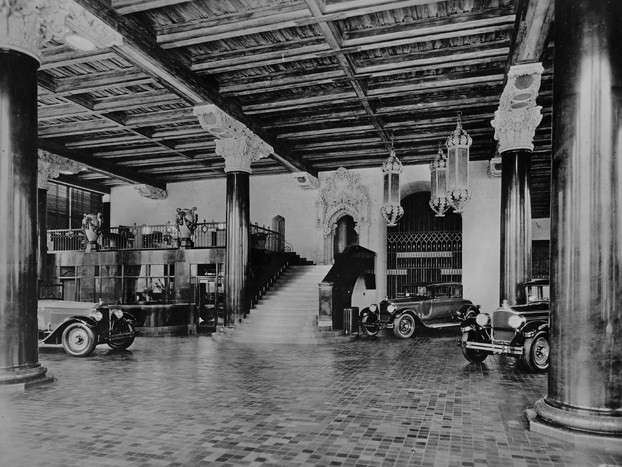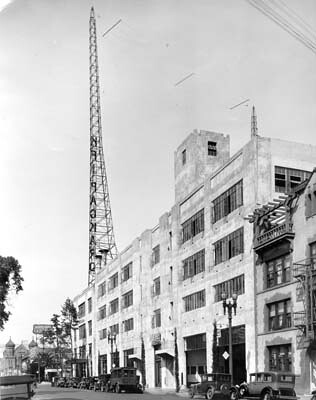Quote:
Originally Posted by tovangar2

Wow, that's very similar to the famous Earle C. Anthony Packard showroom in San Francisco:

packardinfo.com
I think they're Maybeck interiors.
P.S.

lapl
Packard Building, 1000 Hope St at Olympic (1913, addition 1928), Los Angeles
Earle C. Anthony's Packard dealership in downtown Los Angeles.
It was the site of America's first neon sign which simply read "Packard."
(now Packard Lofts LA)
P.P.S. Apparently, according to Bernard Maybeck, Architect of Elegance by Wilson, Mark, the Los Angeles showroom, housed in a wing attached to the Hope & Olympic building (?) was torn down in the 70's, as was Bernard Maybeck's Oakland showroom for Earle C. Anthony Packard. Sorry, it's gone.
Also:
"1928, Los Angeles, Packard Automobile sales room and office interiors, Earle C. Anthony
nm, Los Angeles
Bernard Maybeck; John Parkinson and Donald B. Parkinson, Architects.
Richly decorative, the Los Angeles showroom still effectively housed automobiles of the 1970s.
In the Los Angeles Packard building, designed by John and Donald B. Parkinson, Maybeck's work was limited to the interior finishes and the styling of the executive office suite."
-http://www.verlang.com/sfbay0004ref_bm_11.html
2006 LAT article w/ pix: http://www.veniceinvestments.com/pdf/reopens.pdf
Automobile dealer Earle C. Anthony's family home 1927 by architect Bernard Maybeck | 3431 Waverly Drive | Ivanhoe Hills Los Angeles
 http://www.you-are-here.com/building/family_home.html
http://www.you-are-here.com/building/family_home.html
America's first neon sign, made for Earle C Anthony's LA dealership, 1923, by Georges Claude (the neon sign inventor), Paris:

thelongestlistofthelongeststuffatthelongestdomainnameatlonglast.com |
Neon and Earle C Anthony, a seemingly inexhaustible topic?
Although it has probably been mentioned on NLA, Earle Anthony's "Packard neon"
may have been "one of" the first of its kind in LA. Recent scholarly research seems to have debunked most of the "first" myths concerning the signage but many questions remain unanswered.
http://www.latimes.com/local/la-me-c...htmlstory.html http://www.youtube.com/watch?v=9zE03azLgks
If reports of substantial expense for early neon signs are to be believed, one might expect construction and display of these signs to have been very newsworthy. I'm curious whether a sign with so much presumed and alleged fanfare wasn't contemporaneously captured on film in all of its colorful glory, even if the color was added by hand. The above mentioned scholarly reports establish that available photographic evidence regarding the neon (or neons) is scarce or practially nonexistent. Its/their color/s and address remain elusive. One source discusses red or blue and then there is Hope Street or another address as the most likely electrical plug ins.
http://www.packardclub.org/forum/vie...=1597&start=10 A 1993 Los Angeles Times article dipped its toe in the Anthony-Neon debate by proclaiming the "sign
s" were orange and blue, and displayed at Anthony's Wilshire and La Brea dealership.
http://articles.latimes.com/1993-06-...re-boulevard/2 Another Times article (1991) mentioned the Wilshire-La Brea-Packard neon having glowed in 1929.
http://articles.latimes.com/1991-04-...691_1_neon-art These later attributions do not seem supported by the relevant directories and other common reference sources. Other sources repeat the same La Brea-Wilshire connection.
http://www.wilshirecenter.com/history/ (One can only guess that these articles are referencing the huge sign for the
Fox Ritz Theater, but that is a guess and it is possible that the Ritz sign was not originally neon or another electrified gas.) Digging a little deeper into the LA Brea-Wilshire-neon-EC Anthony mystery, is a 2008-LA City Planning Dept. report. It references a 1950 Sanborn map showing that a building at Wilshire and La Brea was used as an auto sales and service facility, and that 1935-LA Times ads indicate the existence of Ray F. Chesley's used-car dealership. The report also mentions R.L. Lail & Co.s' used
Chevys and Olds. But perhaps most importantly, the report states: "[I]n the mid 1940s through 1950s, [the property] appears to have been known as the Packard-La Brea dealership.
http://cityplanning.lacity.org/EIR/W...lResources.pdf See also
http://neon-sign-8.wikifoundry.com/
Did EC Anthony have an interest in a car dealership or other business at or near the venerable La Brea and Wilshire intersection - with a note worthy neon sign? (I do recall a used car lot there and have heard or read a rumor about a Duesenberg that may have languished on such a lot in the '50s or possibly the '70s.) Do/Does a color photo exist of one of EC Anthony's early LA Packard neon's?
1928
 http://waterandpower.org/Historical_..._Brea_1928.jpg http://skyscraperpage.com/forum/show...ostcount=11841
http://waterandpower.org/Historical_..._Brea_1928.jpg http://skyscraperpage.com/forum/show...ostcount=11841
Feb 25, 1930 Lots graded and ready for development



 http://skyscraperpage.com/forum/show...ostcount=11843
http://skyscraperpage.com/forum/show...ostcount=11843
1930
 http://waterandpower.org/Historical_...shire_1930.jpg
http://waterandpower.org/Historical_...shire_1930.jpg
1954
 http://i231.photobucket.com/albums/e...ngGeneralo.jpg http://forum.skyscraperpage.com/show....php?p=6068007
http://i231.photobucket.com/albums/e...ngGeneralo.jpg http://forum.skyscraperpage.com/show....php?p=6068007
1915 - Earle Anthony auto showroom PRE-NEON,
 http://catalog.library.ca.gov/exlibr...I3S9F22X2D.jpg
http://catalog.library.ca.gov/exlibr...I3S9F22X2D.jpg
BUT - Jan 15, 1914 (?)
Not LA,
 http://3.bp.blogspot.com/-ins9eDGCoo...0/IMG_6633.JPG
http://3.bp.blogspot.com/-ins9eDGCoo...0/IMG_6633.JPG
1929 Packard, 1000 S. Hope (Look to far right above and between what appears to be garage entrance and exit.
Could that be one of LA's earliest neon signs?


)
 http://catalog.library.ca.gov/exlibr...HLEJMJQLIE.jpg
http://catalog.library.ca.gov/exlibr...HLEJMJQLIE.jpg
Guessing the above Packard sign would have been on the outside directly above these two building openings.
 http://catalog.library.ca.gov/exlibr...5N4H1CDRHJ.jpg
http://catalog.library.ca.gov/exlibr...5N4H1CDRHJ.jpg
1930 Nearby United Artists theater, no evidence of neon. (Puzzling why UA would advertise Fox Theater unless there was some sort of an economic tie-in.)
 http://catalog.library.ca.gov/exlibr...F2HHR6Y42K.jpg
http://catalog.library.ca.gov/exlibr...F2HHR6Y42K.jpg
1931 - Was it neon or incandescent?
 http://miraclemilela.files.wordpress...931.jpg?w=1200
http://miraclemilela.files.wordpress...931.jpg?w=1200
1940
http://digitallibrary.usc.edu/cdm/si...id/21737/rec/2











 http://forum.skyscraperpage.com/show...ostcount=11861
http://forum.skyscraperpage.com/show...ostcount=11861



